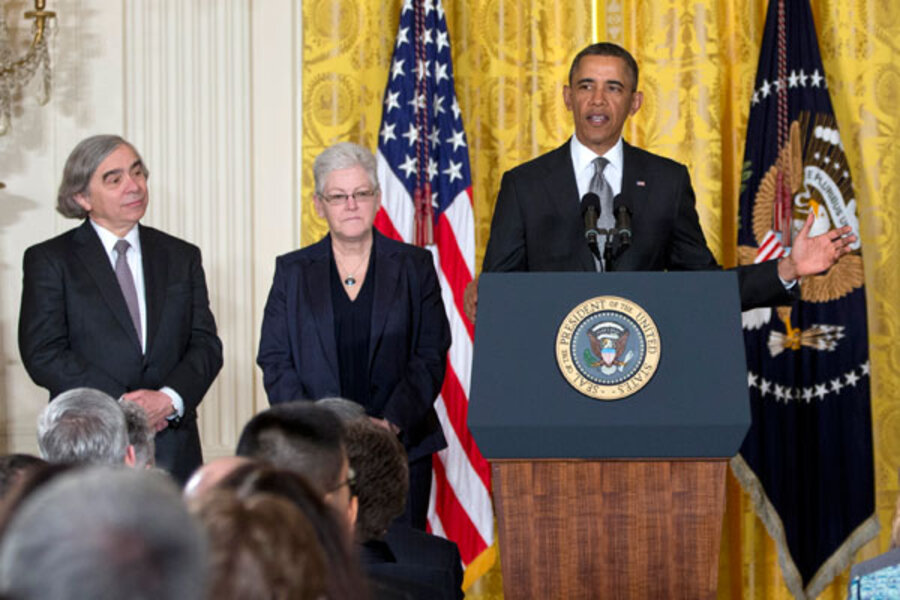Do Obama cabinet picks match his greener second-term talk?
Loading...
In announcing his new choices to lead the Department of Energy and the Environmental Protection Agency Monday, President Obama sent a potentially mixed message about whether he would back up his greener rhetoric since reelection with strong action.
Key decisions loom over major new coal plant emissions regulations as well as new proposals to begin exporting vast amounts of US coal and natural gas to Asia. Mr. Obama's choices offer some indication of how the administration might move forward.
On one hand, his decision to tab Gina McCarthy to lead EPA reinforces the commitment he made in his State of the Union address to curb global warming. As chief of the EPA’s Office of Air and Radiation, Ms. McCarthy is known as a key architect of tough new limits on emissions from power plants.
But Ernest Moniz, his choice to lead the Energy Department, has been a booster of nuclear power and chaired a recent Massachusetts Institute of Technology study advocating the globalization of natural gas trade through liquid natural gas (LNG) exports. The report also looked favorably on hydraulic fracturing or “fracking,” which is opposed by numerous environmental groups.
In some ways, the choices could be a sign that Obama's second-term energy policy will be more of the same. In his first term, Obama embraced an "all of the above" energy policy that vastly expanded US oil and natural gas production as well as renewable energy. At the same time, he directed the EPA to clamp down on power plant greenhouse emissions with tougher regulations. Both choices appear to reinforce that pattern.
Referring to the pair's energy and environmental credentials, Obama said at a press conference Monday: “They're going to be making sure that we're investing in American energy, that we're doing everything that we can to combat the threat of climate change, that we're going to be creating jobs and economic opportunity in the first place. They are going to be a great team. And these are some of my top priorities going forward.”
The choices point to Obama's potential balancing act. He may have aspirations to limit climate change by reducing demand for fossil fuels and replacing them with renewable energy, but that goal could be overwhelmed by a vast expansion of new fossil-energy export proposals.
The new nominees will have a large say over US policy. The Department of Energy approves permits for facilities to ship LNG abroad, and the EPA is involved in reviewing or critiquing environmental impact statements for those facilities. There are at least 24 applications to build LNG export terminals in ports around the US, where tankers would load up with domestically produced natural gas and ship it off to Asia and other energy hungry markets worldwide. The expansion of coal exports with new terminals in Oregon and Washington is also up for consideration.
Environmentalists praised McCarthy but questioned the nomination of Mr. Moniz, a professor of theoretical physics at MIT.
“Moniz has a history of supporting dirty and dangerous energy sources like gas and nuclear power with polluting partners including BP, Shell, Chevron and Saudi Armco,” noted Courtney Abrams of Environment America in a statement.
Members of the energy industry took the opposite view on the two nominees.
“Dr. Moniz’s work indicates an understanding that continued US shale gas development is vital to multiple sectors of the economy and as a means of lowering carbon emissions,” said Salo Zelermyer, a lobbyist at Bracewell & Giuliani, which represents energy companies, in a statement. He “can send an early positive signal by approving pending applications for LNG exports.”
Recent developments in the approval process for the controversial Keystone XL pipeline could provide insight on what lies ahead for LNG and coal. A preliminary report last week suggested that greenhouse emissions from Keystone might be lower than expected – prompting speculation that the administration could be leaning toward approving the deal. The broader lesson for proposed LNG and coal facilities, energy experts say, is that they could be in for a similarly thorough review.
For instance, a recent study by an Energy Department contractor forecast only a modest impact on US natural gas prices if the export terminals are built. But that study is being challenged, which could lead to further Energy Department evaluations during Moniz’s tenure, as well as EPA reviews of those proposals.
Given that the MIT study chaired by Moniz took a favorable view of LNG exports, how likely is Moniz to get his way in Washington? Certainly, he'll contribute, but he might not be able to "shift top-level debate within the White House policy" alone, writes Kevin Book, energy analyst at ClearView Partners, a Washington energy research firm, in an analysis of the appointment.
“We doubt that Dr. Moniz would have accepted the nomination without some assurance of direct influence of energy policy itself," the analysis says. "By the same token, Dr. Moniz is also an experienced Washington player who understands the political overlay of serving 'at the pleasure of the President.' ”
At the end of the day, Moniz at Energy and McCarthy at EPA “reinforce the greenish leanings of the President’s energy policy comments this year,” Mr. Book concludes.







